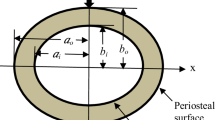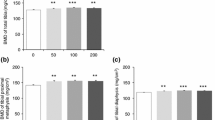Abstract
Recent studies show that green tea polyphenols (GTPs) attenuate bone loss and microstructure deterioration in ovariectomized aged female rats, a model of postmenopausal osteoporosis. This study evaluated the efficacy of GTPs at mitigating bone loss and microstructure deterioration along with related mechanisms in androgen-deficient aged rats, a model of male osteoporosis. A 2 (sham vs. orchidectomy) × 2 (no GTP and 0.5% GTP in drinking water) factorial design was studied for 16 weeks using 40 aged male rats. An additional 10 rats (baseline group) were killed at the beginning of study to provide baseline parameters. There was no difference in femoral mineral density between baseline and the sham only group. Orchidectomy suppressed serum testosterone and tartrate-resistant acid phosphatase concentrations, liver glutathione peroxidase activity, bone mineral density, and bone strength. Orchidectomy also decreased trabecular bone volume, number, and thickness in the distal femur and proximal tibia and bone-formation rate in trabecular bone of proximal tibia but increased serum osteocalcin concentrations and bone-formation rates in the endocortical tibial shaft. GTP supplementation resulted in increased serum osteocalcin concentrations, bone mineral density, and trabecular volume, number, and strength of femur; increased trabecular volume and thickness and bone formation in both the proximal tibia and periosteal tibial shaft; decreased eroded surface in the proximal tibia and endocortical tibial shaft; and increased liver glutathione peroxidase activity. We conclude that GTP supplementation attenuates trabecular and cortical bone loss through increasing bone formation while suppressing bone resorption due to its antioxidant capacity.





Similar content being viewed by others
References
NIH Consensus Development Panel on Osteoporosis Prevention, Diagnosis, and Therapy (2001) Osteoporosis prevention, diagnosis, and therapy. JAMA 285(6):785–795
Nohl H (1993) Involvement of free radicals in ageing: a consequence or cause of senescence. Br Med Bull 49:653–667
Banfi G, Iorio EL, Corsi MM (2008) Oxidative stress, free radicals and bone remodeling. Clin Chem Lab Med 46:1550–1555
Yalin S, Bagis S, Polat G, Dogruer N, Cenk Aksit S, Hatungil R, Erdogan C (2005) Is there a role of free oxygen radicals in primary male osteoporosis? Clin Exp Rheumatol 23:689–692
Basu S, Michaëlsson K, Olofsson S, Johansson S, Melhus H (2001) Association between oxidative stress and bone mineral density. Biochem Biophys Res Commun 288:275–279
Garrett JR, Boyce BF, Oreffo RO, Bonewald L, Poser J, Mundy GR (1990) Oxygen-derived free radicals stimulate osteoclastic bone resorption in rodent bone in vitro and in vivo. J Clin Invest 85:632–639
Yang CS, Landau JM (2000) Effects of tea consumption on nutrition and health. J Nutr 130:2409–2412
Siddiqui IA, Afaq F, Adhami VM, Ahmad N, Mukhtar H (2004) Antioxidants of the beverage tea in promotion of human health. Antioxid Redox Signal 6:571–582
Shen CL, Wang P, Guerrieri J, Yeh JK, Wang JS (2008) Protective effect of green tea polyphenols on bone loss in middle-aged female rats. Osteoporos Int 19:979–990
Shen CL, Yeh JK, Stoecker BJ, Chyu MC, Wang JS (2009) Green tea polyphenols mitigate deterioration of bone microarchitecture in middle-aged female rats. Bone 44:684–690
Reeves PG, Nielsen FH, Fahey GC Jr (1993) AIN-93 purified diets for laboratory rodents: final report of the American Institute of Nutrition ad hoc writing committee on the reformulation of the AIN-76 rodent diet. J Nutr 123:1939–1951
Wang JS, Luo H, Wang P, Tang L, Yu J, Huang T, Cox S, Gao W (2008) Validation of green tea polyphenol biomarkers in a phase II human intervention trial. Food Chem Toxicol 46:232–240
Shen CL, Yeh JK, Cao JJ, Tatum OL, Dagda RY, Wang JS (2009) Green tea polyphenols mitigate bone loss of female rats in a chronic inflammation-induced bone loss model. J Nutr Biochem 21:968–974
Parfitt AM, Drezner MJ, Glorieux FH, Kanis JA, Malluche H, Meunier PJ (1987) Bone histomorphometry: standardization of nomenclature, symbols and units. report of the ASBMR Histomorphometry Nomenclature Committee. J Bone Miner Res 2:595–610
Nielsen FH (2004) Dietary fat composition modifies the effect of boron on bone characteristics and plasma lipids in rats. BioFactors 20:161–171
Crenshaw TD, Peo ER, Lewis AJ Jr, Moser BD (1981) Bone strength as a trait for assessing mineralization in swine: a critical review of techniques involved. J Anim Sci 53:827–835
Paglia DE, Valentine WN (1967) Studies on the quantitative and qualitative characterization of erythrocyte glutathione peroxidase. J Lab Clin Med 70:158–169
Ke HZ, Qi H, Crawford DT, Chidse-Frink KL, Simmons HA, Thompson DD (2000) Lasofoxifene (CP-336, 156), a selective estrogen receptor modulator, prevents bone loss induced by aging and orchidectomy in the adult rat. Endocrinology 141:1338–1344
Wang L, Banu J, McMahan CA, Kalu DN (2001) Male rodent model of age-related bone loss in men. Bone 29:141–148
Tian XY, Chen HY, Setterberg RB, Li M, Jee WSS (2009) Alfacalcidol increases cancellous bone in low turnover, fatty marrow sites in aged, orchidectomized rats. J Musculoskelet Neuronal Interact 9:138–146
Shen CL, Yeh JK, Samathanam C, Cao JJ, Stoecker BJ, Dagda RY, Chyu MC, Dunn DM, Wang JS (2011) Green tea polyphenols attenuate deterioration of bone microarchitecture in female rats with systemic chronic inflammation. Osteoporos Int 22:327–337
Shen CL, Yeh JK, Cao JJ, Wang JS (2009) Green tea and bone metabolism. Nutr Res 29:437–456 (Erratum in Nutr Res 2009;29:684)
Vali B, Rao LG, El-Sohemy A (2007) Epigallocatechin-3-gallate increases the formation of mineralized bone nodules by human osteoblast-like cells. J Nutr Biochem 18:341–347
Chen CH, Ho ML, Chang JK, Hung SH, Wang GJ (2005) Green tea catechin enhances osteogenesis in a bone marrow mesenchymal stem cell line. Osteoporos Int 16:2039–2045
Kamon M, Zhao R, Sakamoto K (2009) Green tea polyphenol (−)-epigallocatechin gallate suppressed the differentiation of murine osteoblastic MC3T3-E1 cells. Cell Biol Int 34:109–116
Nakagawa H, Wachi M, Woo JT, Kato M, Kasai S, Takahashi F, Lee IS, Nagai K (2002) Fenton reaction is primarily involved in a mechanism of (−)-epigallocatechin-3-gallate to induce osteoclastic cell death. Biochem Biophys Res Commun 292:94–101
Hafeez BB, Ahmed S, Wang N, Gupta S, Zhang A, Haqqi TM (2006) Green tea polyphenols induced apoptosis in human osteosarcoma SAOS-2 cells involves a caspase-dependent mechanism with downregulation of nuclear factor-kappaB. Toxicol Appl Pharmacol 216:11–19
Neilson AP, Li Y, Hannon K, Ferruzzi MG, Watkins BA (2006) Accumulation of catechins in bone and liver of mice fed green tea while under physical stress. FASEB J 20:A570
Acknowledgement
This study was supported by Winthrop-University Hospital and Texas Tech University Health Sciences Centers.
Author information
Authors and Affiliations
Corresponding author
Additional information
Partial results were communicated at the Annual Meeting of American Society for Bone and Mineral Research.
The authors have stated that they have no conflict of interest.
Rights and permissions
About this article
Cite this article
Shen, CL., Cao, J.J., Dagda, R.Y. et al. Supplementation with Green Tea Polyphenols Improves Bone Microstructure and Quality in Aged, Orchidectomized Rats. Calcif Tissue Int 88, 455–463 (2011). https://doi.org/10.1007/s00223-011-9477-1
Received:
Accepted:
Published:
Issue Date:
DOI: https://doi.org/10.1007/s00223-011-9477-1




